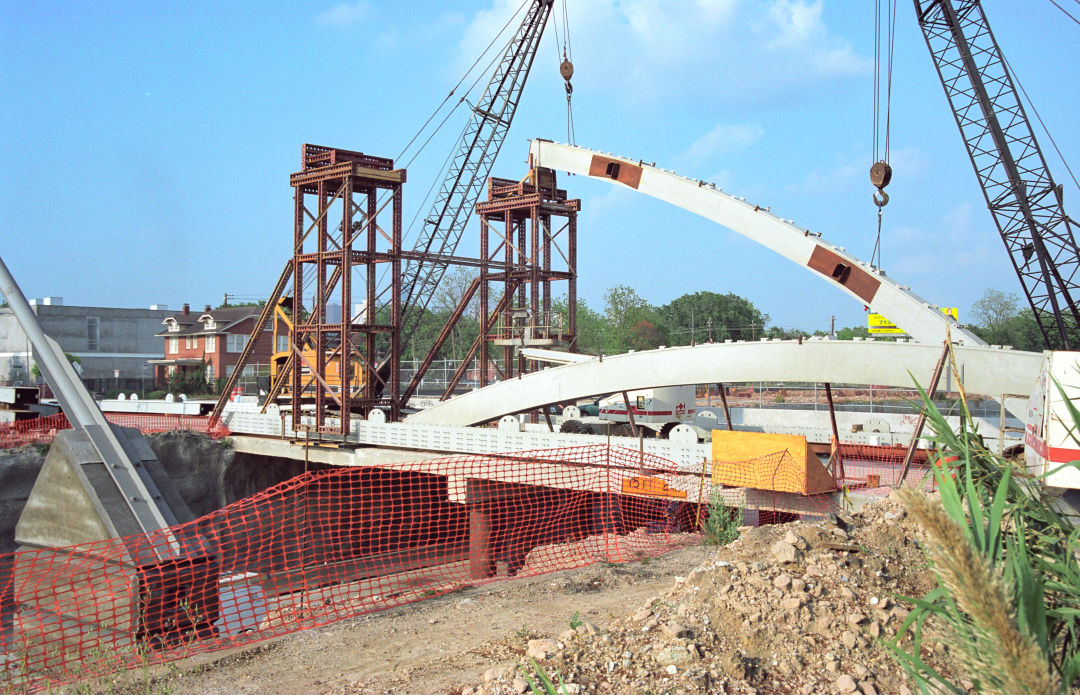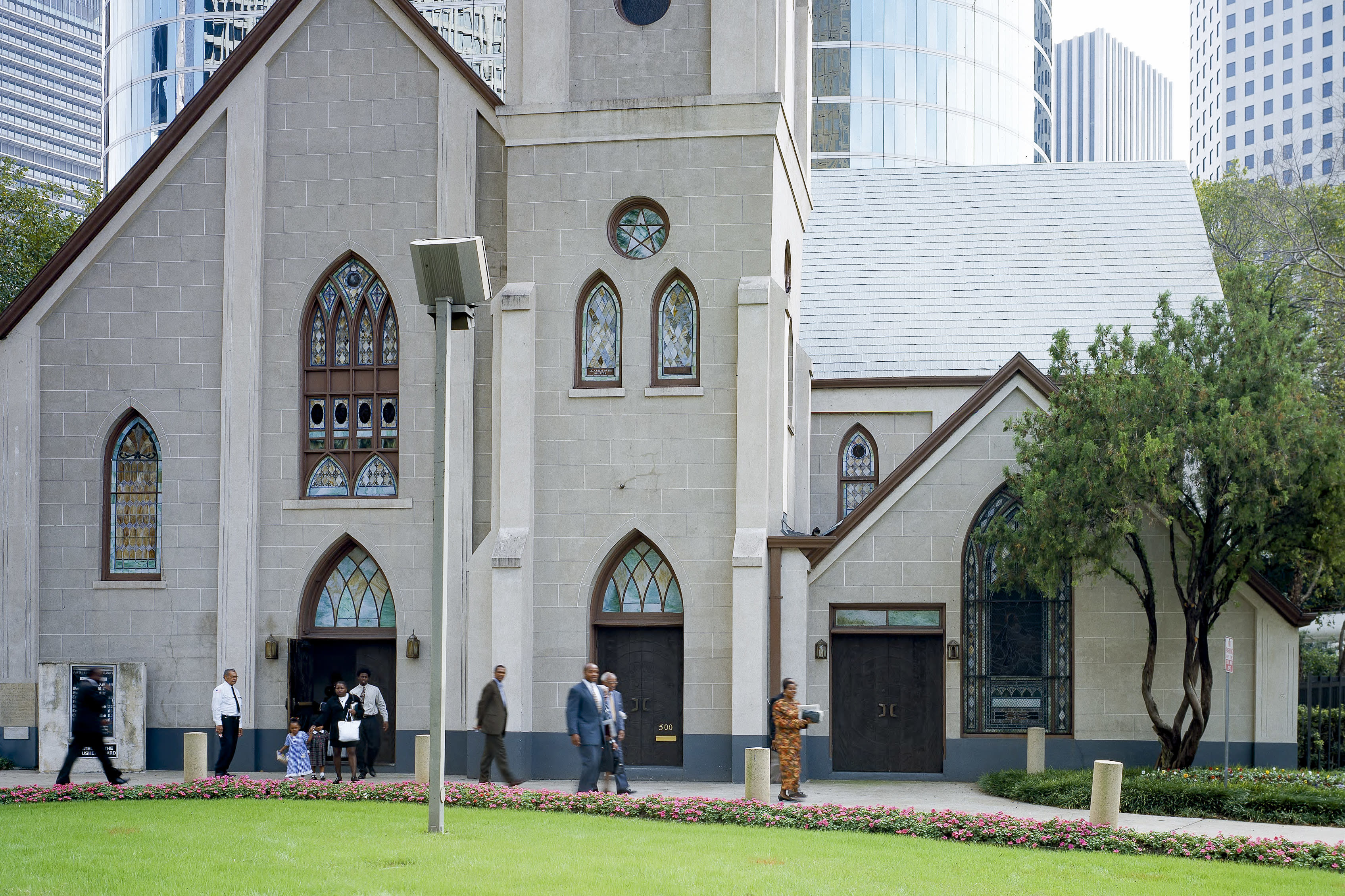How Montrose Boulevard Became the Typical Houston Composite

The Link-Lee mansion on Montrose Boulevard circa 1916, with John Wiley Link's children playing in the yard.

Every month in Houstonia, James Glassman, a.k.a the Houstorian, sheds light on a piece of the city’s history.
Houston’s messy, grimy Montrose Boulevard is also historic, beautiful, and … hilarious.
Starting from the iconic Mecom Fountain at the edge of Hermann Park and cutting through the Museum District, the street is where Texas oil tycoons built their first mansions. Montrose Boulevard later slouched into proto-suburban sprawl mode, with a mélange of building types, assorted characters, and sketchy activities, where Houston’s counterculture was born and, in many ways, survives today. So, how exactly did this composite of Houston’s best and worst features become one of the city’s signature streets?
In the first two decades of the twentieth century, Houston was growing quickly due in large part to the birth of the modern oil industry. So-called streetcar suburbs grew out on the then-western edge of town. Courtlandt Place, Westmoreland, Avondale, Audubon Place, and The Montrose Addition provided middle-income and high-end homes for Houstonians looking to live outside of the city—which at that point, contained only downtown.
Houston Land Corporation developed the area and planned mansions along Montrose Boulevard, which was divided with an esplanade and lined with palm trees, such was the style for upscale Southern neighborhoods in those decades. At the corner of West Alabama, the impressive Link-Lee mansion remains from that era, and has served as an administrative building for the University of St. Thomas since 1946.

The Present day Link-Lee mansion is part of St. Thomas University's campus.
Future industrialist Howard Hughes, Jr. grew up one block off of Montrose Boulevard, while Texaco founder Joseph Cullinan established the exclusive and restricted enclave Shadyside at the southern end of the boulevard.
Houston has never had formal zoning to dictate what and where things are built, often relying instead on neighborhoods’ own deed restrictions. By 1936, the deed restrictions for the neighborhoods surrounding Montrose Boulevard expired, allowing for nonresidential and, in many cases, unrestricted-use buildings to replace the street’s tony mansions. The best of these new buildings included the Plaza Hotel near Bissonnet, three churches, and the Tower Community strip mall (one of the first in the nation). The coming decades would see such architectural invasive species as varied as six gas stations, five high-rises, a few fast-food joints, a Walgreens, and a Kroger (popularly known as Disco Kroger). Not so fancy anymore.
A 1942 civic master plan proposed a road connecting Montrose Boulevard (which had terminated at Westheimer) northward across Buffalo Bayou to the Heights, further altering the character of the once-sleepy street. The new portion of the boulevard, with its wide, leafy esplanade, reflected the smaller scale residential character of the newer Hyde Park subdivision, while the original esplanades south of Westheimer were removed.
In the postwar years, Houston became increasingly decentralized as Houstonians continued their migration further outward, fueled by the proliferation of cars and an abundance of cheap, unrestricted land. Just as Montrose Boulevard and adjoining blocks had been designed to bring new residents, even newer subdivisions began to lure Montrosians away. The slow exodus hastened the lapsed deed restrictions, which, in turn, set the stage for Montrose the neighborhood, as a composite of connected subdivisions, to transform into the wild, funky, artsy, and gay community that it still resembles today … depending on whom you ask. Indeed, Montrose has remnants of the 1960s and ’70s folk music scene, cultivated by the likes of Townes Van Zandt and Guy Clark, who both lived and performed around Montrose Boulevard. In fact, landmark live music venue Anderson Fair remains just off of Montrose at Welch and continues to feature singer-songwriters.
Lelia Rodgers, who owned the pub Rudyard’s from 1993 until 2022, believed the intersection of Montrose and Westheimer was “the heart of that street.” She recalls vividly the various dearly departed street fairs throughout the ’80s and ’90s, where Houston’s funkiness was on full display. She marveled at the Montrose wildlife, like the roller-skating collective the Urban Animals, street jousting between vendor stalls, while mingling with the rando carrying a boa constrictor, and seeing bands playing in parking lots. Punks, folkies, bohemians, and self-identified freaks felt at home in shabby Montrose.

Paul Kittelson's sculpture really livened up the 59 overpass.
In the 1960s, the Southwest Freeway stretched over Montrose Boulevard, parallel to Southern Pacific’s Texas and New Orleans Railroad line. Before the freeway was rebuilt in its current state below grade, the covered section at street level was iffy during the day, and downright dangerous at night. In a bid to improve the vibe, DiverseWorks installed a friendly, foam dinosaur sculpture by Paul Kittelson at the dark underpass in 1986.
In the early 1980s, real estate developer John Hansen made drastic improvements to several blocks at the intersection of Montrose and Richmond Avenue. In four blocks, he was able to accomplish something the city had been unable to do: fix Montrose Boulevard, at least on a micro scale. Making design decisions such as installing wider sidewalks with thoughtful landscaping that exalted those beloved live oaks, Hansen made Montrose more welcoming and pedestrian-friendly. Unlike other blocks, that stretch of the street has a convenient turning lane in the center and no curbside parking. To top it off, Hansen renovated the abandoned 1946 Central Church of Christ, opened the popular Black Labrador restaurant and bar with an adjacent jazz club, and ensured Houston Public Library could open a Montrose branch in the converted sanctuary. (Houston Public Library just announced their departure date, and promises the new Montrose branch will open soon at the Montrose Collective.)
Current Hansen Partners managing partner John Andell says that Hansen believed his projects “did not end with the building, but extended into beautiful landscaping, safe, walkable sidewalks, and ease of access.” Today, the expansive tree canopy is a monument to his foresight. Montrose residents are currently arguing over which existing Montrose Boulevard trees should be saved, and where new ones should be installed.

The construction of the Montrose bridge at 59, before it was surrounded by a bunch of high-rises.
Image: Courtesy HoustonFreeways.com
Likewise, developer Steve Zimmerman also saw the inherent value in the messy, unregulated boulevard. He bought one of the remaining original mansions (built by Humble Oil founder Walter Fondren) and converted it into an ultra-fancy hotel, La Colombe d’Or. Further south, where the US 59 overpass bisects Montrose Boulevard, he opened the intimate wine bar Zimm’s, sadly now closed.
Today, Montrose Boulevard seems to be changing daily. Three tall apartment developments loom over the historic street. Large, empty lots hint at big projects coming soon. Gone are classic Montrose Boulevard institutions like the Black Lab, the River Cafe, Butera’s, Half Price Books, Disco Kroger and adjacent KPFT, Mary’s, the Tower Theatre, Ruggles, and La Strada. Even the Gay Pride Parade, which crossed Montrose Boulevard for decades, relocated downtown.
The Montrose TIRZ has shared its plan to fix the chronically neglected street by dragging a proverbial comb from the Southwest Freeway all the way to Buffalo Bayou, in hopes of improving drainage and accessibility, and tidying up the slightly-resistant-to-revitalization hood. This Upper Kirby–style makeover, while desperately needed for decades, has oddly not yet been embraced by a majority of the neighbors. I recommend more live oaks, and maybe a dinosaur sculpture.




